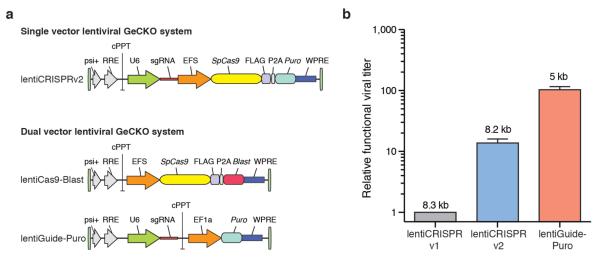Figure 1.

New lentiviral CRISPR designs produce viruses with higher functional titer.
(a) Lentiviral expression vector for Streptococcus pyogenes Cas9 and sgRNA in the improved one vector system (lentiCRISPR v2) and the two vector system (lentiCas9-Blast, lentiGuide-Puro). Psi packaging signal (psi+), rev response element (RRE), central polypurine tract (cPPT), elongation factor-1α short promoter (EFS), FLAG octapeptide tag (FLAG), 2A self-cleaving peptide (P2A), puromycin selection marker (puro), posttranscriptional regulatory element (WPRE), blasticidin selection marker (blast), and elongation factor-1α promoter (EF1a). (b) Relative functional viral titer of viruses made from lentiCRISPR v11, lentiCRISPR v2, and lentiGuide-Puro vector with a EGFP-targeting sgRNA (n = 3 independently-transfected virus batches with 3 replicate transductions per construct). HEK293FT cells were transduced with serial dilutions of virus and, after 24 hours, selected using puromycin (1 ug/ml). Puromycin-resistant cells were measured after 4 days from the start of selection using the CellTiter-Glo (Promega) luciferase assay. Relative titers were calculated using viral volumes that yielded less than 20% puromycin-resistant cells in order to minimize the number of cells with multiple infections. Numbers above each bar indicate the size of the packaged virus for each construct.
